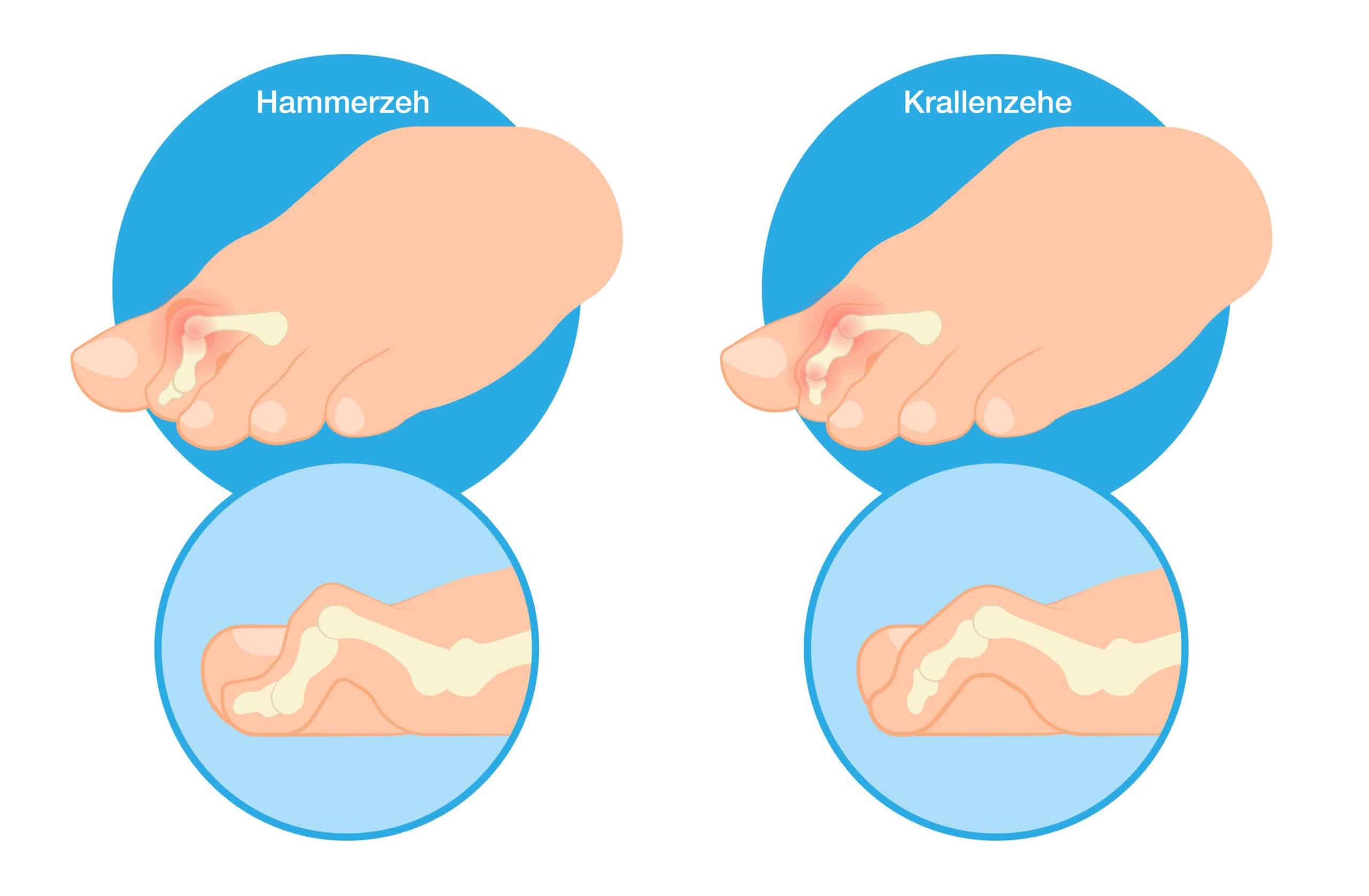In this article about hammertoe & claw toe, you will learn everything important about hammertoe/claw toe as well as interesting info about hammertoe/claw toe surgery, from hammertoe/claw toe experts Dr. Klaus Pastl & PD Dr. Stephan Puchner. They clarify symptoms, causes, as well as the various methods of treatment. Read which treatment method is best for your hammer toe or claw toe: conservative therapies such as insoles and special shoes, or surgery after all? Before surgery, find out which surgical materials can be used for you and whether bone screws (screws made from human bone), such as the Shark Screw®, would be an option for your malposition!
Reading time: 5 min
Author of the article:Dr. Klaus Pastl
Foot surgeon and hammer toe / claw toe specialist in Linz
The author is a renowned specialist in Austria for foot surgery and hammertoe & claw toe surgery.
Updated 02.12.2022
What is a hammer toe / claw toe - what is the difference?
A hammer toe (also called hallux malleus or digitus malleus) and a claw toe are both toe deformities that usually affect the second to fourth toes. These deformities are manifested by flexion in the middle phalanx of the toe. In claw toe, the proximal phalanx is also hyperextended, and the “claw-in” of the toes is also visually conspicuous in claw toe. In hammer toe, the end phalanx of the toe thereby points to the ground like a hammer. The constant contact therefore causes pressure points and thus pain. Even a slight misalignment can cause pain. Often, a hammer toe also brings with it a problem: “Finding suitable shoes becomes a real challenge,” says expert Dr. Klaus Pastl.
A hammer toe is the most common toe deformity. In many cases, those affected also suffer from other foot malpositions such as hallux valgus, splayfoot, flatfoot or high arch. Most often, a hammertoe develops during life and is rarely congenital.

What are the causes of hammer toe or claw toe?
There are many factors that can contribute to causing toe misalignment. One of these causes of a hammer toe is the wrong footwear. Because shoes that are too small, too narrow or too high can compress the toes, which can weaken the foot muscles. This causes the toes to become less and less controllable. Initially, the deformity of the toe can still be bent by hand, but in later stages the toe remains in its bent position and a hammer toe/claw toe develops.
In addition, patients who have pre-existing foot conditions may be more likely to develop hammertoe/claw toe than patients who do not have pre-existing foot conditions. Common diseases and pre-existing conditions include flatfoot, splayfoot, high arch or hallux valgus. “These pre-existing conditions lead to an incorrect load on the foot and can thereby promote a hammer toe” according to hammer toe & claw toe experts, Dr. Klaus Pastl & PD Dr. Puchner, who relies on Shark Screw® for surgery to correct deformities.
It often happens that after accidents, the so-called compartment syndrome occurs. This impairs blood circulation and subsequently irreversibly disrupts the function of muscles and nerves. This can cause the toe muscles to tighten incorrectly, and hammertoes as well as claw toes can form.
Rheumatism, a chronic joint inflammation, can also promote the development of claw toes and hammer toes, as it usually occurs in the toe joints as well.
Do you need help with your claw toe, your hammer toe or would you like to clarify if you suffer from hammer toe? We are happy to recommend specialists in your area who can help you manage the symptoms. Find out here why many patients and doctors rely on the use of screws made from human bone for surgery.
What are the symptoms of hammer toe or claw toe?
It doesn’t always have to be that a hammer toe or claw toe will necessarily cause problems or pain. Most of the time, it is more of a purely cosmetic problem. At this stage, surgery is not recommended. However, if the deformity progresses further, hammertoes and claw toes may develop more horny calluses like corns on the toes and balls of the feet. As a result, sufferers may experience severe pain when wearing shoes and are restricted in their movement. The malposition can also displace other toes. “In the worst case, these can even be dislocated in the basic joint and thus lose their functional ability,” says specialist PD Dr. Puchner from Vienna.
The symptoms occur regardless of the severity of the claw toe or hammer toe. Thus, a slight malposition can already cause enormous pain, whereas again a severe toe malposition does not cause any problems for some sufferers. The sensation of pain varies from person to person. If you are unsure, we recommend that you seek advice from an orthopedist and podiatrist.
Do you need help with your claw toes or hammertoes, but you are not sure which doctor is the right one for your problem? We will be happy to recommend a doctor in your area without obligation!
How is the diagnosis of hammer toe/claw toe made?
In most cases, a visual diagnosis is sufficient for hammertoe and claw toe, as they have a very characteristic appearance. The attending physician then checks the mobility of the toe. A distinction is made between a stiff (contracted) hammer toe and a flexible hammer toe. In the case of a flexible form of hammer toe, the doctor can compensate for the curvature by pressing on the sole of the foot. This is not the case with a contracted form of the hammer toe. The distinction between the two forms is important for the course of further treatment.
What helps with hammer toe or claw toe? - the tools
Basically, a distinction is made between conservative and surgical methods for hammer toe & claw toe. However, this depends on how pronounced the toe malposition is and whether the toe can still be passively extended. If the deformity is still in its early stages, conservative, i.e. non-surgical methods should be tried first to get the symptoms of the hammer toe or claw toe under control. It can already be helpful to widen the toe box in shoes. It is therefore advisable to give the toes more space in the shoe so that curvature can be prevented. Furthermore, so-called orthoses or padding and felt rings can prevent the hammer toe & claw toe from developing further and the symptoms from worsening. Special orthopedic insoles for shoes also prevent the development of pressure damage. Toe gymnastics as well as adequate foot care also contribute greatly to preventing hammertoes or claw toes, or stopping them in their progression. Patients often ask the question: Can a hammer toe / claw toe be taped? Taping the hammer toe or claw toe stabilizes the toe and keeps it in place. Especially with a slight curvature hammertoes & claw toes can be corrected so. However, tapes do not in any case cause the existing curvature to regress.
When is hammertoe / claw toe surgery an option?
If the success of conservative methods does not last and the hammertoe/claw toe does not show improvement, hammertoe/claw toe surgery should be considered. There are various surgical methods that are used depending on the degree of toe malposition. Thus, whether the toe can still be moved and how much the toe is curved is critical. Surgery for a hammer toe or claw toe usually takes 15 to 20 minutes. These operations are usually performed under general or local anesthesia. “A very gentle method to correct a hammer toe or claw toe is by means of Shark Screw®. This eliminates the risk for the patient of a second operation to remove the metal, since Shark Screw® is converted to the patient’s own bone,” advises the hammertoe and claw toe expert from Linz, Dr. Klaus Pastl.
Your hammer toe & claw toe is already in an advanced stage and conservative methods do not achieve success? We will be happy to recommend a suitable specialist, free of charge, in your area, who can talk to you about possible solutions!
What is the procedure for hammertoe / claw toe surgery?
Before hammertoe & claw toe surgery, the doctor distinguishes between a contracted deformity and a flexible deformity. The doctor will examine your toe and assess how well it can still move. Depending on this, different surgical techniques are used. The following techniques for hammer toe /claw toe surgery are explained here:
Surgical techniques
PIP Arthrodesis
PIP arthrodesis is one of the most common surgical methods for hammertoe or claw toe deformity. In the process, the joint surfaces are removed and subsequently joined. This means that the affected, contracted and painful hammertoe joint is stiffened. This is usually done with a screw made from human bone, since cells can migrate from one bone fragment to the other via the screw, which usually allows the two joint ends to grow together well. Another option is to connect these joint surfaces with a metal wire. However, the patient bears the risk that germs may enter the wound at the point where the wire protrudes from the skin. In addition, these wires must be removed again during a second operation.
Hohmann
In Hohmann’s surgery, the toe bone is shortened and part of the joint is removed. The affected toe becomes shorter as a result. The tactile function, and thus the stability, is impaired. The soft tissues, such as the tendons, are relieved.
Weil osteotomy
The Weil osteotomy can only be performed in cases of flexible malposition. This involves cutting through the bone in the area of the metatarsal head, which leads to relaxation of the soft tissue situation and correction of the malposition. A Weil osteotomy is also often used for metatarsalgia. The two bone fragments are joined with screws made from human bone.
Surgical materials
Material | Vorteile | Risiken |
Shark Screw® / Schraube aus menschlichen Knochen | Integration der Shark Screw® in den Patientenknochen durch den Knochenumbauprozess | Keine Metallentfernung | Wetterfühligkeit nicht bekannt | Geringe Schmerzen nach der Operation | Hohe Festigkeit | 1-4 Wochen nach der Operation besondere Vorsicht bei der Belastung |
Metalldrähte | Günstiges Versorgungskonzept für Kliniken (geringe Materialkosten) | Einsatz bei Allergien sollte vermieden werden | Metallentfernung sehr wahrscheinlich | Durchbohrt der Draht in den Wochen nach der Operation die Hautoberfläche, besteht das Risiko, dass Keime eintreten können. Entzündungen und Infekte wären die Folge. |
Shark Screw® for hammer toe & claw toe
Can the Shark Screw® help with a hammer toe or claw toe? Absolutely. After insertion of the Shark Screw® into the bone, it is colonized by the body’s own cells and integrated into the natural bone remodeling process. This is made possible by the so-called Havers channels, because the body’s own vessels and bone cells can settle and spread in these channels. This process creates new, patient-specific bone structures that adapt to the mechanical demands of the foot. Read more about the Shark Screw® bone screw here.
Do you have a hammer toe or claw toe, want to be treated with the Shark Screw® or seek a second opinion? We will be happy to recommend suitable orthopedists in your region!
How to prevent hammer toe or claw toe?
It is important to pay attention to the appropriate footwear, so flat shoes and shoes in which the toes have enough space are ideal. There is a danger with shoes with too high heels, because they put a lot of stress on the forefoot and are generally conducive to deformities. To prevent foot diseases, it is recommended to do a lot of exercise with flat shoes or, if possible, to go barefoot.
What is the aftercare of hammertoe / claw toe surgery?
It is important that after hammertoe & claw toe surgery, the foot is elevated and cooled as often as possible to avoid possible swelling. To promote mobility of the operated toe, specific exercises as well as physiotherapy should be performed. In addition, until 2 months after the operation, wide shoes should be worn, in which the toes really have room. Tight and too high shoes should be avoided. If walking sticks or special shoes are still needed, you should refrain from driving.



